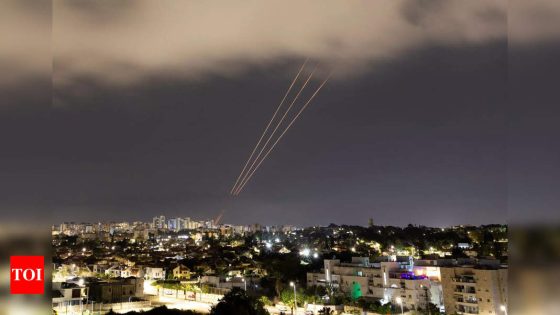In a dramatic escalation of Middle Eastern tensions, Iran launched a historic and direct aerial assault on Israel late on Saturday. This unprecedented attack involved over 200 drones and missiles, marking the first time Iran has directly targeted Israeli territory. The assault has heightened fears of a broader regional conflict, particularly as the United States expresses unwavering support for Israel.
Here are key developments:
Initial strike: The Iranian offensive began late on Saturday with the launch of a swarm of explosive drones and missiles targeting Israeli soil.This marks Iran’s first direct assault on Israel, escalating long-standing hostilities to a new level.
Booms and sirens in Israel: Booms and air raid sirens were reported in numerous places including northern Israel, southern Israel, the northern West Bank and the Dead Sea near the Jordanian border. The attack marked the first time Iran has launched a direct military assault on Israel, despite decades of enmity dating back to the country’s 1979 Islamic Revolution. Authorities said a 7-year-old girl was critically injured.
Israeli’s response: Rear Admiral Daniel Hagari of the Israeli military reported that the attack comprised more than 200 drones and missiles. Despite the volume of fire, Israel’s advanced defense systems intercepted the majority of these threats.
US involvement: President Joe Biden returned to Washington to coordinate a response, emphasizing the US’s “ironclad” support for Israel. US forces actively participated in intercepting incoming drones.
The Pentagon reported that defense secretary Lloyd Austin had spoken with his Israeli counterpart “to discuss urgent regional threats … and made clear that Israel could count on full US support to defend Israel against any attacks by Iran and its regional proxies.” National security adviser Jake Sullivan also spoke with his counterpart to reinforce Washington’s “ironclad commitment to the security of Israel.”
Global reactions: International responses were swift, with the United Nations Secretary-General condemning the attack and various nations expressing concern over the potential for a regional escalation.
UN Security Council meeting: Following Israel’s request, the UN Security Council scheduled an emergency meeting to discuss the attack and Israel’s request to designate the Iranian Revolutionary Guard Corps as a terrorist organization.
‘Death to Israel’: Thousands of Iranians gathered in the streets of Iran early Sunday to express their support for the ongoing unprecedented drone and missile attack against their archenemy, Israel.
“Death to Israel!” and “Death to America!” were the chants heard from demonstrators in Tehran’s Palestine Square shortly after the Revolutionary Guards declared the start of Operation Honest Promise.
A new mural was revealed in the square, bearing the message “the next slap is fiercer.” This was alongside a large banner that had been displayed for days, warning in Hebrew, “take shelter.”
During the demonstration on Sunday, participants proudly waved Iranian and Palestinian flags, as well as banners proclaiming “God’s victory is near.”
Regional tensions: The attack occurs amidst the ongoing Gaza war, with conflicts also flaring on other fronts involving Lebanon and Syria, underscoring the volatile regional dynamics.
Hezbollah’s involvement: Early on Sunday, Hezbollah claimed responsibility for firing rockets at an Israeli base, indicating the involvement of Iran’s regional allies in the conflict.
Continued threats: Iranian officials warned of more severe responses if Israel continues its military actions, highlighting the precariousness of the situation and the potential for further violence.
(With inputs from agencies)
Here are key developments:
Initial strike: The Iranian offensive began late on Saturday with the launch of a swarm of explosive drones and missiles targeting Israeli soil.This marks Iran’s first direct assault on Israel, escalating long-standing hostilities to a new level.
Booms and sirens in Israel: Booms and air raid sirens were reported in numerous places including northern Israel, southern Israel, the northern West Bank and the Dead Sea near the Jordanian border. The attack marked the first time Iran has launched a direct military assault on Israel, despite decades of enmity dating back to the country’s 1979 Islamic Revolution. Authorities said a 7-year-old girl was critically injured.
Israeli’s response: Rear Admiral Daniel Hagari of the Israeli military reported that the attack comprised more than 200 drones and missiles. Despite the volume of fire, Israel’s advanced defense systems intercepted the majority of these threats.
US involvement: President Joe Biden returned to Washington to coordinate a response, emphasizing the US’s “ironclad” support for Israel. US forces actively participated in intercepting incoming drones.
The Pentagon reported that defense secretary Lloyd Austin had spoken with his Israeli counterpart “to discuss urgent regional threats … and made clear that Israel could count on full US support to defend Israel against any attacks by Iran and its regional proxies.” National security adviser Jake Sullivan also spoke with his counterpart to reinforce Washington’s “ironclad commitment to the security of Israel.”
Global reactions: International responses were swift, with the United Nations Secretary-General condemning the attack and various nations expressing concern over the potential for a regional escalation.
UN Security Council meeting: Following Israel’s request, the UN Security Council scheduled an emergency meeting to discuss the attack and Israel’s request to designate the Iranian Revolutionary Guard Corps as a terrorist organization.
‘Death to Israel’: Thousands of Iranians gathered in the streets of Iran early Sunday to express their support for the ongoing unprecedented drone and missile attack against their archenemy, Israel.
“Death to Israel!” and “Death to America!” were the chants heard from demonstrators in Tehran’s Palestine Square shortly after the Revolutionary Guards declared the start of Operation Honest Promise.
A new mural was revealed in the square, bearing the message “the next slap is fiercer.” This was alongside a large banner that had been displayed for days, warning in Hebrew, “take shelter.”
During the demonstration on Sunday, participants proudly waved Iranian and Palestinian flags, as well as banners proclaiming “God’s victory is near.”
Regional tensions: The attack occurs amidst the ongoing Gaza war, with conflicts also flaring on other fronts involving Lebanon and Syria, underscoring the volatile regional dynamics.
Hezbollah’s involvement: Early on Sunday, Hezbollah claimed responsibility for firing rockets at an Israeli base, indicating the involvement of Iran’s regional allies in the conflict.
Continued threats: Iranian officials warned of more severe responses if Israel continues its military actions, highlighting the precariousness of the situation and the potential for further violence.
(With inputs from agencies)
Source Agencies



